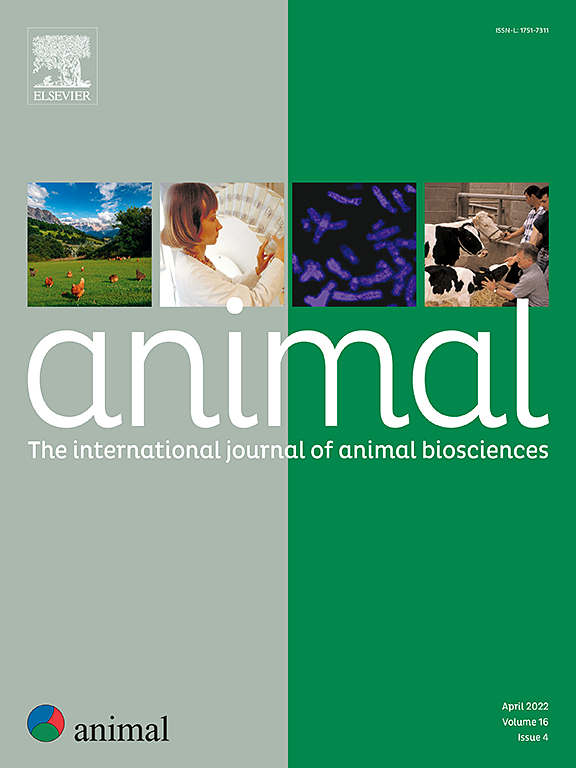利用全基因组序列数据中的优先变异,揭示猪脂肪相关性状的新颖且密切相关的关联信号
IF 4
2区 农林科学
Q1 AGRICULTURE, DAIRY & ANIMAL SCIENCE
引用次数: 0
摘要
对于大多数生产性状,最大比例的遗传变异仍未绘制。密集的全基因组序列(WGS)数据使发现新的关联成为可能,并以标记阵列无法达到的分辨率揭示密切相关的关联信号。然而,从WGS数据中识别导致复杂性状变异的变异受到高维数和连锁不平衡的阻碍。因此,在最好的情况下,我们可以缩小因果变量的范围,优先考虑一组变量的后验验证。在这项研究中,我们评估了WGS数据的效用,以杜洛克猪群体的脂肪含量和组成性状为模型,揭示了较弱影响的关联,我们之前描述了LEPR和SCD基因的主要影响。我们从205个测序个体中发现的WGS变异中筛选出154个候选基因中的182个变异,对971头猪进行了基因分型。这些变异是有条件的LEPR和SCD。然后在971头猪的确认集中测试了优先变异与目标性状的关联。共有17个潜在独立的数量性状位点(占研究基因总数的8.4%)显著相关(q值<;0.05),至少具有一项研究性状。我们发现了可归因于ABCC2、MOGAT2或PLPP1等基因的新关联,分别与背膘厚度、肉豆汁酸含量和单不饱和脂肪酸含量有关。我们的研究结果还揭示了在DGAT2和FADS2基因周围的基因座中存在更细粒度的较弱遗传效应,这些基因座可能分别掩盖了位置较近的基因如MOGAT2和DAGLA的影响。为了完善验证研究的变异优先级,特别是针对那些较弱的效应,我们建议更大更多样化的发现集,更精确和完整的功能基因注释,以及整合其他组学数据。本文章由计算机程序翻译,如有差异,请以英文原文为准。
Unravelling novel and closely linked association signals for fat-related traits in pigs using prioritised variants from whole-genome sequence data
For most production traits, the largest proportions of genetic variance remain unmapped. Dense whole-genome sequence (WGS) data enable the possibility of discovering novel associations as well as unravelling closely linked association signals with a resolution that marker arrays cannot reach. However, the identification of variants from WGS data that are causal of the variation of complex traits is hindered by the high dimensionality and linkage disequilibrium. Thus, at best, we can narrow the circle around the causal variants to prioritise a set of variants for their posterior validation. In this study, we assessed the utility of WGS data for uncovering associations of weaker effects using, as a model, fat content and composition traits in a Duroc pig population where we previously described major effects of the LEPR and SCD genes. We genotyped 971 pigs for a set of 182 variants from 154 candidate genes that were prioritised from amongst the WGS variants discovered in 205 sequenced individuals. These variants were prioritised conditional to LEPR and SCD. The association of the prioritised variants with the target traits was then tested in the confirmation set of 971 pigs. A total of 17 potentially independent quantitative trait loci (8.4% of the total number of studied genes) were significantly associated (q-value < 0.05) with at least one of the studied traits. We identified novel associations attributable to genes such as ABCC2, MOGAT2, or PLPP1 for backfat thickness, myristic acid content, and monounsaturated fatty acid content, respectively. Our results also revealed a finer granularity of weaker genetic effects in loci such as those around the DGAT2 and FADS2 genes, which may mask the effects of closely located genes like MOGAT2 and DAGLA, respectively. To refine the prioritisation of variants for validation studies, especially when targeting those of weaker effects, we recommend larger and more diverse discovery sets, more precise and complete functional gene annotation, and the integration of other omics data.
求助全文
通过发布文献求助,成功后即可免费获取论文全文。
去求助
来源期刊

Animal
农林科学-奶制品与动物科学
CiteScore
7.50
自引率
2.80%
发文量
246
审稿时长
3 months
期刊介绍:
Editorial board
animal attracts the best research in animal biology and animal systems from across the spectrum of the agricultural, biomedical, and environmental sciences. It is the central element in an exciting collaboration between the British Society of Animal Science (BSAS), Institut National de la Recherche Agronomique (INRA) and the European Federation of Animal Science (EAAP) and represents a merging of three scientific journals: Animal Science; Animal Research; Reproduction, Nutrition, Development. animal publishes original cutting-edge research, ''hot'' topics and horizon-scanning reviews on animal-related aspects of the life sciences at the molecular, cellular, organ, whole animal and production system levels. The main subject areas include: breeding and genetics; nutrition; physiology and functional biology of systems; behaviour, health and welfare; farming systems, environmental impact and climate change; product quality, human health and well-being. Animal models and papers dealing with the integration of research between these topics and their impact on the environment and people are particularly welcome.
 求助内容:
求助内容: 应助结果提醒方式:
应助结果提醒方式:


